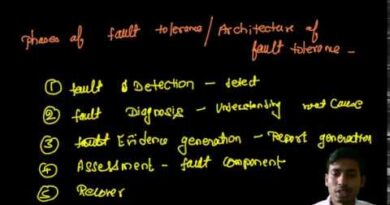MULTICAST COMMUNICATION-TOTAL ORDERING OF ATOMIC ORDERING-BROADCAST AND MULTICAST
Total Order Broadcast and Multicast Algorithms Multicast Communication-Total Ordering Of Atomic Ordering-Broadcast and Multicast. Total Order Broadcast and Multicast Algorithms Atomic Broadcast/Multicast Group Communication in Distributed System Reliable Communication in Distributed System. FIFO Communication in Distributed System Causal Communication in Distributed System Totally Ordered Multicast Totally Ordered Broadcast Fast Atomic Multicast Message Ordering and Group Communication.
Ordered Multicast In Distributed Systems Total Order Multicast Atomic Multicast In Distributed Systems Atomic Multicast In Distributed System Video Lecture Totally Ordered Broadcast Algorithm Reliability And Ordering Of Multicast Fifo Ordering Multicast.
Contents
- 0.1 Multicast Communication and Ordering Guarantees
- 0.2 1. Atomic Ordering in Multicast Communication
- 0.3 2. Total Ordering of Messages
- 0.4 3. Broadcast vs. Multicast
- 1 🔄 Multicast Communication in Distributed Systems
- 2 🔐 Atomic Broadcast and Multicast
- 3 🕒 Total Ordering
- 4 ⚙️ How Is Total Order Achieved?
- 5 📦 Broadcast vs Multicast
- 6 🔁 Summary
Multicast Communication and Ordering Guarantees
Multicast communication is a method of data transmission where a message is sent from one sender to multiple receivers. It is commonly used in distributed systems, networks, and group communications.
1. Atomic Ordering in Multicast Communication
Atomic ordering ensures that all messages in a multicast system are delivered either to all recipients or to none, preventing partial deliveries.
2. Total Ordering of Messages
Total ordering guarantees that all processes in the system receive messages in the same order. It ensures consistency in distributed systems, preventing race conditions and inconsistencies.
- Methods for achieving total ordering:
- Centralized Sequencer – A single process assigns sequence numbers to messages.
- Distributed Agreement – Protocols like Paxos or Lamport Timestamps are used to determine order.
- Causal Ordering – Ensures messages that are causally related are received in the correct sequence.
3. Broadcast vs. Multicast
| Feature | Broadcast | Multicast |
|---|---|---|
| Scope | Sent to all nodes in the network | Sent to a specific group of nodes |
| Efficiency | Can be inefficient due to unnecessary delivery | More efficient as only intended recipients receive it |
| Use Case | ARP requests, network-wide announcements | Video conferencing, stock market data distribution |
Would you like more details on a specific aspect, such as protocols for total ordering?
Here’s a clear breakdown of Multicast Communication with emphasis on Total Ordering and Atomic Broadcast / Multicast in distributed systems:
🔄 Multicast Communication in Distributed Systems
Multicast is a communication method where a message is sent from one process to a group of processes simultaneously.
It is used when:
-
All group members need the same information (e.g., in distributed databases, replicated state machines).
-
Coordination among nodes is needed.
🔐 Atomic Broadcast and Multicast
✅ Atomic Broadcast (or Reliable Broadcast)
Ensures that:
-
All or Nothing Delivery: If one correct process delivers a message, all correct processes deliver it.
-
No Duplication: A message is delivered at most once.
-
Integrity: If a correct process broadcasts a message, it will eventually be delivered.
-
Total Order (when extended): All processes deliver messages in the same order.
📡 Atomic Multicast
-
Like atomic broadcast, but messages are delivered only to subgroups.
-
Useful when only a subset of processes need certain messages.
🕒 Total Ordering
🧾 What Is It?
Total order means:
If two processes deliver the same two messages, they deliver them in the same order.
🔄 Types of Ordering in Multicast:
| Type of Order | Description |
|---|---|
| Unordered | Messages may be received in different orders. |
| FIFO Ordering | Messages from the same sender are received in the order they were sent. |
| Causal Ordering | If message A causally precedes message B, all processes deliver A before B. |
| Total Ordering | All messages are delivered in the same global order by all processes. |
⚙️ How Is Total Order Achieved?
Common Algorithms:
-
Sequencer-Based:
-
One process assigns sequence numbers to messages.
-
All processes deliver messages in increasing order of these sequence numbers.
-
-
Logical Clocks (Lamport Timestamps):
-
Each message is timestamped.
-
Messages are delivered in timestamp order (with tie-breaking for concurrent messages).
-
-
Vector Clocks:
-
Used for causal and total ordering.
-
More complex, but captures causality precisely.
-
-
Consensus-Based:
-
Use algorithms like Paxos or Raft to agree on message order.
-
📦 Broadcast vs Multicast
| Feature | Broadcast | Multicast |
|---|---|---|
| Target | All nodes | Specific group of nodes |
| Efficiency | Less efficient | More bandwidth-efficient |
| Use Case | General message delivery | Group communication, replicas |
🔁 Summary
-
Multicast = Message to group
-
Atomic Broadcast = Reliable and uniform message delivery
-
Total Ordering = Same delivery order on all nodes
-
Used in: replication, coordination, consensus algorithms
Would you like an example algorithm (like Lamport’s or Sequencer-based Total Order Multicast), or a diagram to help visualize it?

